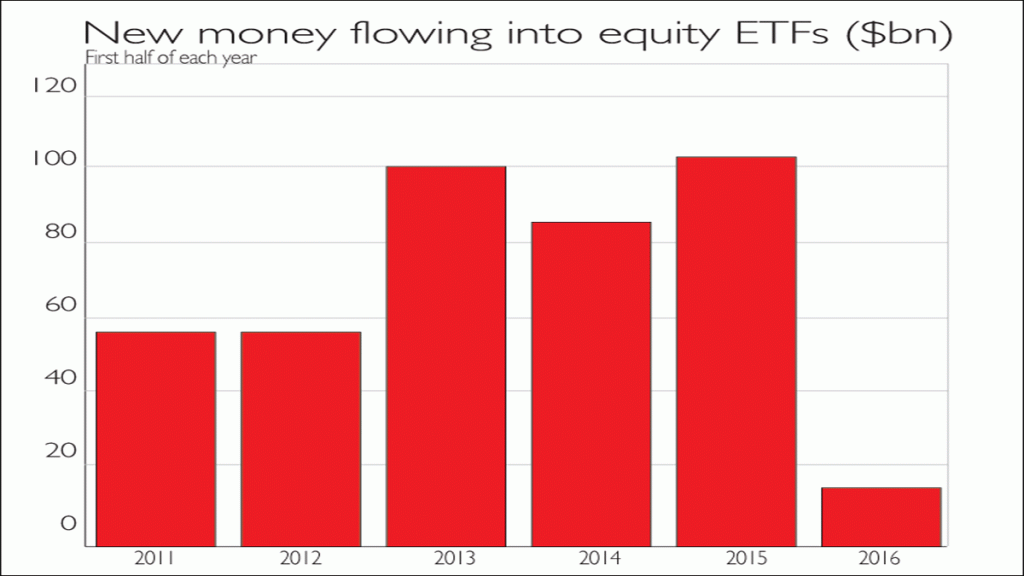
Exchange-traded funds (ETFs) have become increasingly popular with investors in recent years and now hold several trillions of dollars in assets around the world. But recent figures have raised questions about whether the rapid growth in the use of these funds is coming to an end.
The amount of new money invested into equity ETFs fell by more than 80% in the first six months of this year, down to less than $20bn from over $100bn last year, according to ETFGI, a consultancy. ETFs invested in European stocks were worst hit, with $22.1bn pulled out of the funds during the six months to June, according to BlackRock (which owns the iShares ETF range).
The migration away from equity ETFs is a “rare sign of pressure” on the passive investment industry, writes Attracta Mooney in the FT. Passive funds such as ETFs, which aim to track the market as cheaply as possible, have been drawing investors away from more expensive active funds for several years after active managers consistently underperformed the market.
But now WisdomTree, a US-listed manager that exclusively runs ETFs, has become the most-shorted investment firm (meaning that traders expect its share price to fall). WisdomTree, which runs $38.7bn of assets and is the largest listed ETF specialist, is seen “as a bellwether for the health of the ETF market”.
Still, do a few slow months really imply the ETF boom is over? Admittedly, the amounts of money pulled out of some equity ETFs have been significant. But most of these redemptions probably have fairly straightforward explanations. Investors are more likely to have been driven by economic trends that affected which investments and regions they favoured rather than a desire to pull their money out of specific types of fund.
For example, the beginning of the year saw fairly volatile trading conditions, brought on by concerns about China’s slowing growth and currency devaluation, falling oil prices and uncertainty over the US Federal Reserve’s rate-hike plans. So it’s not too surprising that many people wanted to reduce their exposure to equities in general. High levels of redemption from ETFs with exposure to Europe can partly be explained by concerns that European markets would struggle if the UK voted to leave the EU, as well as concerns about other EU economies such as the potential risks in Italy’s heavily indebted banking system.
Indeed, the global ETF market has continued to grow, albeit more slowly than before. Total assets in all exchange-traded products (ETPs) – which include funds that track assets such as commodities as well as more straightforward equity and bond ETFs – reached $3.31trn in July, according to BlackRock, up from $2.96trn at the end of 2015. And ETFs with exposure to different regions appear to have benefited from investors shifting away from Europe.
ETFs focusing on Asia-Pacific excluding Japan experienced recorded inflows of $11bn during the first half of 2016, with total assets under management reaching $123bn. Emerging markets and North America-focused ETFs also experienced larger inflows this year than in the same period last year. Bond ETFs also saw a rise in inflows and are on course for a record year, according to BlackRock, while demand for safe haven assets have led to inflows into gold ETFs.
So, despite some eye-catching outflows, it’s unlikely that this signals the end of the ETF revolution.
The fight over hidden fees
Campaigners for greater transparency in the investment industry have insisted that hidden fund fees remain “a festering sore on the face of financial services”, after the Investment Association (IA), the fund managers’ body, published a report claiming that the problem of concealed charges did not exist. The IA’s report looked at the performance of 1,350 equity funds over three years, subtracting an average figure for fund fees and charges from benchmark index returns to find the post-fee returns investors should expect to achieve.
According to the IA, actual equity fund returns were 0.71% above index returns per annum, higher than the -1.59% underperformance that would have been expected based on costs. Consequently, there was “zero evidence” that funds’ returns are affected by hidden fees, said the IA, which called them the “Loch Ness Monster” of investments.
However, Gina Miller of wealth manager SCM Private, who runs The True and Fair Campaign against hidden fees, criticised the report’s methodology as being “amateurish”. Miller argued that the research focused solely on dealing commissions and omitted important elements of transaction costs, such as bid/offer spreads. In addition, it failed to account for “survivorship bias”, whereby successful funds continue to do well and grow, while poorly performing funds are often closed, meaning their disappointing returns are not included in data.